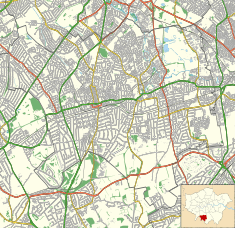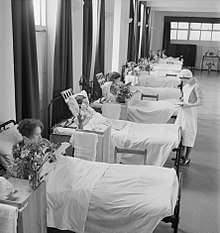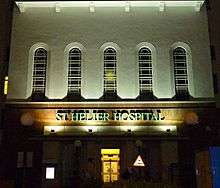St Helier Hospital
St Helier Hospital (full title: St Helier Hospital and Queen Mary's Hospital for Children) in the London Borough of Sutton is run by Epsom and St Helier University Hospitals NHS Trust along with Epsom Hospital. It is located next to the large St Helier council estate and close to the major intersection known as Rosehill.
| St Helier Hospital and Queen Mary's Hospital for Children | |
|---|---|
| Epsom and St Helier University Hospitals NHS Trust | |
.jpg) | |
 Shown in Sutton | |
| Geography | |
| Location | Wrythe Lane, St Helier, Sutton, Carshalton SM5 1AA, London, England, United Kingdom |
| Coordinates | 51°22′49″N 0°11′01″W |
| Organisation | |
| Care system | NHS England |
| Type | District General Hospital |
| Affiliated university | St George's, University of London |
| Services | |
| Emergency department | Yes Accident & Emergency |
| Beds | 629 |
| History | |
| Opened | 26 March 1938 |
| Links | |
| Website | http://www.epsom-sthelier.nhs.uk |
| Lists | Hospitals in England |
The hospital offers a full range of hospital services including a 24-hour accident and emergency department. The site is also home to the South West Renal and Transplantation Service and the Queen Mary's Hospital for Children, a dedicated children's hospital. St Helier Hospital is a major teaching hospital for St George's, University of London, and is a main teaching site for medical degrees.
History


The hospital was commissioned in 1934 when Surrey County Council acquired a 999-year lease of 10 acres of land on the St Helier council estate which had been named in honour of Mary Jeune, Baroness St Helier, a prominent alderman on the London County Council.[1] Queen Mary laid the foundation stone for the new hospital on 26 March 1938.[1] It was designed by Saxon Snell & Phillips, who were chosen for their experience in hospital design, in the thirties modernist style.[2] It received its first patients in February 1941 during Second World War.[1]
Less than a month later, the hospital was damaged in a bombing raid by a parachute mine.[1] John Major, the former Prime Minister was born in the hospital in 1943.[3] Further damage was caused in later raids and the hospital was struck by two flying bombs in June 1944.[4] St Helier Hospital remained functional throughout the War and was painted green to make it less visible to German bombers in the latter years of the war.[5] It joined the National Health Service in 1948.[1]
The Queen Mother visited the hospital in 1963, during the hospital's jubilee year and, in 1987, Diana Princess of Wales opened the new maternity unit.[1] Services were transferred from Queen Mary's Hospital for Children in 1993.[6] St Helier Hospital came under the management of the Epsom and St Helier University Hospitals NHS Trust in 1999.[7]
In November 2013, as part of the Better Services Better Value Review of NHS services in London, the Trust proposed the downgrading of the maternity and Accident and Emergency Departments.[8]
Services
The main building is divided into three blocks: A, B and C. The other buildings are:[9]
- The pathology block (labelled D) which also contains the genitourinary medicine clinic
- The Women's Health Block (labelled E) (which contains the maternity and gynaecology wards, gynaecology clinics and delivery suite)
- Ferguson House (labelled F) (contains some outpatient clinics, administration departments and undergraduate teaching suite)
- Queen Mary's Hospital for Children (labelled J)
- The renal block (labelled K)
Transport links
The nearest London Underground station is Morden Underground station, from which there are frequent buses to the hospital via Rose Hill (about 5 minutes walk from the hospital). Some of the buses that stop outside the hospital are the 151, 157, S1 and S4.[10][11][12] The nearest National Rail station is St Helier station which is slightly less than one mile from the hospital (about a 15-minute walk), although this is infrequently served (only 1 train every 30 minutes off-peak).[13]
Notable births
- John Major - Prime Minister of the United Kingdom 1990-1997 [15]
See also
References
- "St Helier Hospital". Lost Hospitals of London. Retrieved 1 July 2018.
- Hyatt, Christine. "A Brief History of St. Helier Hospital". Sutton Local Records and Archives, London Borough of Sutton.
- There is a plaque at the main entrance of the hospital stating this.
- Roberts, Zoe (7 May 2010). "History of St.Helier Hospital The first Foundation stone". Sutton Local Records and Archives, London Borough of Sutton.
- "Epsom and St Helier NHS trust – Our Story". St Helier Hospital. Epsom and St Helier University Hospitals. Retrieved 11 August 2015.
- "Queen Mary's Hospital". Lost Hospitals of London. Retrieved 11 April 2019.
- "Epsom and St Helier University Hospitals NHS Trust: Financing Application". NHS Trust Development Authority. Retrieved 11 April 2019.
- "GPs vote against closure of local A&E". Pulse. 2 December 2013. Retrieved 2 December 2013.
- "Site map". Epsom and St Helier University Hospitals NHS TRust. Retrieved 1 July 2018.
- "Bus timetable: 151 from Shotfield to Worcester Park". Transport for London. Retrieved 5 June 2018.
- "Bus timetable: 157 towards Morden Station". Transport for London. Retrieved 5 June 2018.
- "Bus timetable: S1 from Banstead". Transport for London. Retrieved 5 June 2018.
- "St Helier London Rail Station". Transport for London. Retrieved 1 July 2018.
- "About Elliot Colburn". Elliot Colburn. Retrieved 14 December 2019.
- https://www.yourlocalguardian.co.uk/news/1346430.john-major-in-bid-to-save-hospital-where-he-was-born/
Further reading
- Peacock, D. Two O'Clock at the Gate: A Nurses Training During the Fifties. Victoria, BC: Trafford, 2008. ISBN 1-4251-6249-5.